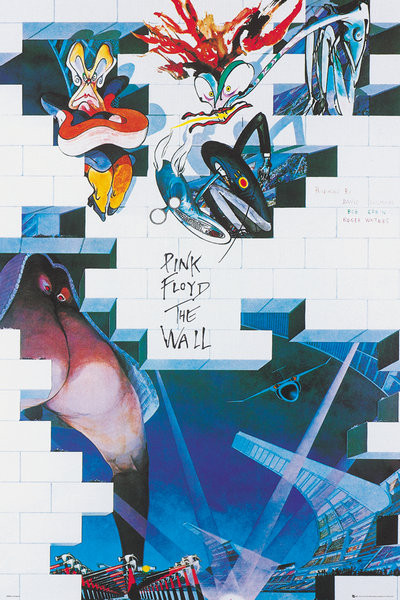
Pink Floyd's album "The Wall" is a concept album released in 1979 and is considered one of their most iconic and influential works. It explores themes of isolation, disillusionment, and personal struggle, with a storyline that follows the life of a fictional character named Pink. The album is a collaboration between Roger Waters, the band's bassist and lyricist, and the other band members: David Gilmour (guitar), Richard Wright (keyboards), and Nick Mason (drums).
"The Wall" is divided into two parts, reflecting the double LP format of its original release. Here are the tracks and a brief description of each:
"The Wall" is divided into two parts, reflecting the double LP format of its original release. Here are the tracks and a brief description of each:

Part 1:
- "In the Flesh?": The album begins with an introduction to the character Pink, a rock star, and sets the stage for the narrative.
- "The Thin Ice": Pink's childhood experiences, including the death of his father in World War II, are explored in this track.
- "Another Brick in the Wall (Part I)": Pink's isolation and emotional detachment begin to manifest, symbolized by the construction of metaphorical "bricks" in his mental wall.
- "The Happiest Days of Our Lives": This track addresses Pink's troubled experiences with authority figures during his school years.
- "Another Brick in the Wall (Part II)": One of the album's most well-known songs, it highlights Pink's rebellion against oppressive schooling and calls for collective resistance.
- "Mother": Pink's relationship with his overprotective mother is examined, delving into the roots of his emotional issues.
- "Goodbye Blue Sky": This track reflects on the impact of war on Pink's psyche, with references to World War II and the Cold War.
Part 2:
- "Empty Spaces": Pink's mental state deteriorates further, leading to feelings of emptiness and alienation.
- "Young Lust": Pink explores his desires and sexual frustration, set against a backdrop of fame and hedonism.
- "One of My Turns": This track depicts Pink's descent into madness and his mistreatment of a romantic partner.
- "Don't Leave Me Now": Pink's plea to his partner not to abandon him, representing his fear of abandonment and deep-seated insecurities.
- "Another Brick in the Wall (Part III)": The third part of the "Another Brick in the Wall" trilogy, this song represents Pink's internal struggle and the reinforcement of his emotional barriers.
- "Goodbye Cruel World": The first half of the album concludes with Pink's decision to isolate himself completely from the world.
Part 3:
- "Hey You": Pink experiences feelings of loneliness and disconnection from society, leading to a cry for help.
- "Is There Anybody Out There?": The song reflects Pink's yearning for human connection and his increasing desperation.
- "Nobody Home": Pink, now a famous rock star, finds himself alone in a hotel room, grappling with feelings of emptiness and depression.
- "Vera": This track references Vera Lynn, a symbol of hope and unity during World War II, contrasting with Pink's disillusionment.
- "Bring the Boys Back Home": A plea to end the war, this song expresses Pink's desire for compassion and unity.
- "Comfortably Numb": Considered one of Pink Floyd's greatest tracks, it explores Pink's dissociation from reality and his eventual surrender to numbness.
- "The Show Must Go On": This song encapsulates Pink's struggle to maintain his public persona despite his deteriorating mental state.
- "In the Flesh": The character Pink creates an oppressive and fascist society in his imagination, reflecting his isolation and desire for control.
- "Run Like Hell": Pink's paranoia intensifies, leading to a climactic sequence where he imagines a violent crowd chasing him.
- "Waiting for the Worms": Pink's self-destructive thoughts take over, portraying his descent into totalitarianism.
- "Stop": This track serves as a wake-up call to Pink, urging him to break free from his self-imposed mental prison.
- "The Trial": A surreal courtroom scene where Pink's inner demons are put on trial, representing his self-analysis and reckoning.
- "Outside the Wall": The album concludes with Pink's metaphorical wall crumbling, symbolizing his emotional breakthrough and reconnection with the world.



Pink Floyd was formed in London in 1965 and became one of the most influential rock bands in history. Their members underwent changes over the years, but the most notable lineup consisted of Roger Waters, David Gilmour, Richard Wright, and Nick Mason. The band's sound is characterized by atmospheric and psychedelic rock, incorporating elements of progressive rock, art rock, and blues.
"The Wall" was primarily written by Roger Waters, drawing heavily from his personal experiences and feelings of alienation. The album's narrative explores the themes of mental health, the consequences of war, and the challenges of fame. It was a commercial success, spawning hit singles like "Another Brick in the Wall (Part II)" and "Comfortably Numb," and it remains one of Pink Floyd's most critically acclaimed and best-selling albums.
"The Wall" was primarily written by Roger Waters, drawing heavily from his personal experiences and feelings of alienation. The album's narrative explores the themes of mental health, the consequences of war, and the challenges of fame. It was a commercial success, spawning hit singles like "Another Brick in the Wall (Part II)" and "Comfortably Numb," and it remains one of Pink Floyd's most critically acclaimed and best-selling albums.
Explore the iconic album "The Wall" by Pink Floyd, featuring a compelling storyline of personal struggle and isolation. Discover the track details and delve into the band's influential history and sound.
Keywords: Pink Floyd, The Wall, concept album, tracks, storyline, Roger Waters, David Gilmour, Richard Wright, Nick Mason, isolation, disillusionment, personal struggle, rock music, progressive rock, art rock, psychedelic rock, mental health, war, fame, iconic, influential.
Keywords: Pink Floyd, The Wall, concept album, tracks, storyline, Roger Waters, David Gilmour, Richard Wright, Nick Mason, isolation, disillusionment, personal struggle, rock music, progressive rock, art rock, psychedelic rock, mental health, war, fame, iconic, influential.
